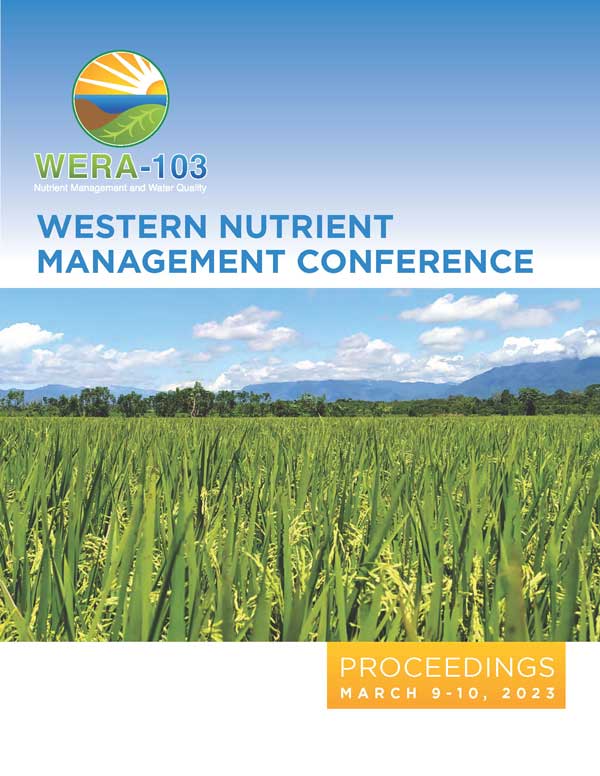Download the Conference Proceedings
Proceedings
Authors
| Filter results10 paper(s) found. |
|---|
1. Digital Tools to Improve Sustainable Agriculture PracticesVisualizations have been shown to promote learning and understanding and to aid in analysis and problem solving. Many concepts in agriculture are well suited to demonstrations that are used in classroom settings or part of training events. However, many demonstrations are difficult to seed in a large setting, or take more time than can be allotted. A series of demonstrations were either filmed or created in animation to provide a digital means by which trainers could more easily train their students,... R. Flynn, J. Walworth, J. Davenport, A. Ulery, D. Bloedel, J. Gleason |
2. Can the “Diviner” Probe Help Explain Water Use by Field Crops?Farms in New Mexico rely on various methods of irrigation but primarily flood or sprinkler systems. Timing irrigations to meet crop water needs using regulated ditch systems is not based on the actual need of the crops. However, pressurized systems that utilize groundwater have the ability to be adjusted to deliver variable amounts of water. A survey of irrigation practices was done in the Pecos River Valley by installing tubes in fields of pecan, alfalfa, corn, chile, and cotton and scanning... R. Flynn |
3. Do 1:1 Soil Extracts for Salinity Underestimate Leaching Fractions?Soil test laboratories often include 1:1 pH and salinity measures as part of their routine analysis. The saturated paste method is also a choice but may not be selected due to a higher cost associated with the procedure. Historical crop response to salinity has been largely carried out using the saturated paste extract procedure. Plant response estimates to salinity are based on the saturated paste method. Leaching fractions are determined from the saturated paste extract as well. Recommendations... R. Flynn, A. Ulery |
4. Identifying Saline and Sodic SoilsSoil salinity can become a sever limitation to crop yields and soil quality. Routine evaluation of salinity often involves a 1:1 extract of water to soil. However, salinity tolerance has been defined from saturated paste extracts, not 1:1. Saturated extracts take more time to determine in the lab but is the best method to ascertain crop susceptibility to yield loss. Mathematical conversions from 1:1 to saturated paste are possible to do but may not translate across regions. In a similar way, determine... R. Flynn |
5. Pecan Response to Foliar Nickel ApplicationsNew Mexico’s pecan industry is one of the state’s most important agricultural assets. In 2010, pecan growers in Dona Ana County produced 19,504 kg of pecans, on over 10,000 ha and was worth over $123 million dollars, making Dona Ana county the number one pecan producing county in the nation. Nickel (Ni) is a component of the enzyme urease which is critical for the mobilization of nitrogen within the pecan tree. Deficiency symptoms are often expressed in pecan as a “mouse-ear”... R. Flynn, R. Heerema, S. Moran duran |
6. Boron Fertilization of Chile Pepper Under Greenhouse ConditionsMany chile (Capsicum annuum) growers apply boron (B) without knowing if B is actually needed. The application of B has been suggested to improve specific conditions that limit chile productivity such as alleviating blossom-end rot. Two varieties of chile were grown (159 days) under greenhouse conditions in silica sand and irrigated with seven levels of B (no B, 0.025 mg L-1, 0.05 mg L-1, 0.1 mg L-1, 0.25 mg L-1, 0.5 mg L-1, 1.0 mg L-1) and complete nutrient solution. Leaf B increased linearly... W. Lindemann, R. Flynn, C. Carr, R. Steiner |
7. An Excel Based Workbook for Assisting with Water Quality InterpretationsClientele using the NMSU Soil, Water, and Agricultural Testing laboratory, as well other commercial labs, are usually given an irrigation water interpretation guideline in the form of a table with acceptable ranges. This approach, while helpful, does not quickly identify areas of concern to the client nor does it assist with estimating leaching fractions when salinity levels are high enough to warrant reclamation. A Microsoft Excel based workbook was developed to assist professionals and clients... R. Flynn |
8. Evaluation of Soil-applied Eddha-chelated Iron Fertilizer for Use in Correcting Iron Deficiency Symptoms in Mature Pecan Trees in the Pecos Basin, New MexicoSoils in the Pecos Basin of New Mexico are characterized by pH 7.5-8.5 and lime content 15-30%. Under these conditions pecan trees are prone to micronutrient deficiencies; pecan trees throughout the basin exhibit interveinal leaf chlorosis symptoms characteristic of iron (Fe) deficiency. In orchards where the Fe chlorosis symptoms occur, affected trees are typically scattered through the orchard in no apparent pattern. Foliar application of ferrous sulfate fertilizer sprays (as well as other micronutrient... R. Heerema, R. Flynn |
9. Soil Characteristics of New Mexico Vineyards: Management ImplicationsA growing viticulture industry in New Mexico has sparked a need to establish best management practices for the climate and soil conditions present across the state. A survey of soil and water characteristics in established New Mexico vineyards was performed so that appropriate management strategies could be developed and limitations could be identified. Soil nitrogen levels varied from low to high indicating potential problems. Plant tissue testing needs to be included in a phosphorus nutrition... R. Flynn |
10. Cover Crops and Compost Amendments for Organic Grape ProductionIncreased costs of fertilizers that rely on petroleum products coupled with increased pest control and transportation costs has prompted more management practices that can make use of local waste products and utilize cover crops to reduce purchased inputs. A burgeoning wine industry could benefit from organic production techniques; however, their effects on vine growth and grape quality have not been explored in New Mexico. Alternative vineyard floor management systems were evaluated for organic... A. Ulery, R. Flynn, R. Walser, M. Weiss, S. Guldan |
